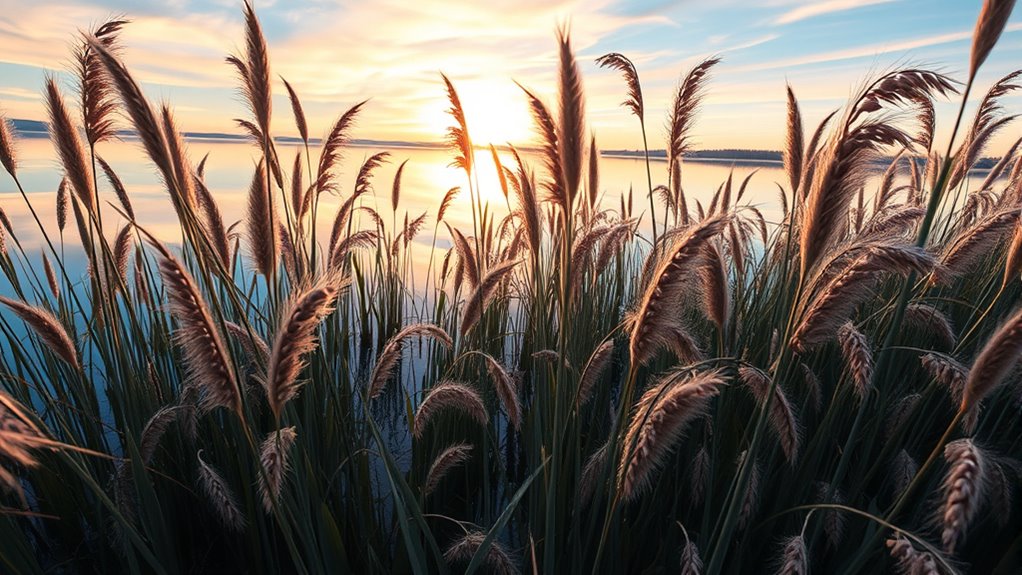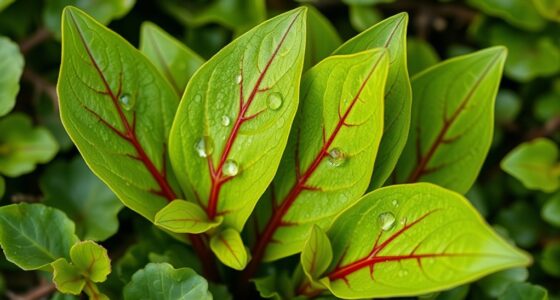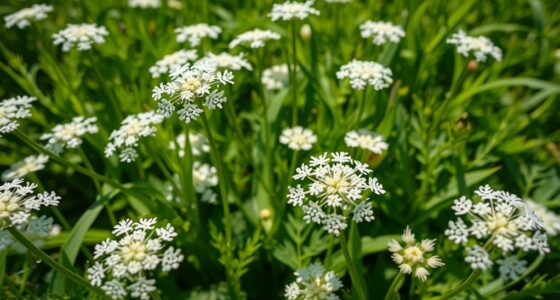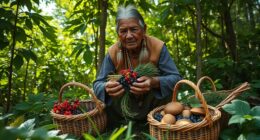Foraging for wild rice requires you to understand its preferred habitats, like shallow, nutrient-rich waters with calm flows. You should harvest during late summer when the grains are ripe, using traditional techniques that involve gentle knocking and respectful practices. Proper processing guarantees the rice stays fresh and flavorful. Recognizing its cultural significance and the importance of sustainable harvesting helps protect this aquatic delicacy for future generations—keep exploring further to discover more about its ecological and cultural richness.
Key Takeaways
- Wild rice thrives in shallow, nutrient-rich, calm waters like lakes, rivers, and marshes during late summer harvest season.
- Harvesting involves traditional methods using lightweight canoes and long knockers, emphasizing sustainability and cultural practices.
- Monitoring water levels, plant color, and growth stages ensures optimal harvest timing and ecosystem health.
- Proper processing includes parching, rinsing, and storing rice in airtight containers to preserve quality.
- Conservation efforts focus on habitat protection, respecting Indigenous traditions, and avoiding ecosystem damage during foraging.
Understanding Wild Rice Habitats and Growth Conditions

Have you ever wondered what makes a perfect environment for wild rice to thrive? Wild rice prefers water less than 2 feet deep, providing enough space for its tall stalks to grow. You’ll find it in soft, mucky, or silty bottoms that supply essential nutrients.
Calm or slightly flowing waters are ideal, as strong currents can hinder growth. Clear water environments are common habitats, especially in lakes, ponds, rivers, and streams. The presence of aquatic plants can influence water quality and habitat stability, further supporting wild rice growth.
It grows best in temperate climates with plenty of sunlight, which supports photosynthesis. Nutrient-rich conditions and a balanced pH help promote healthy development. Water quality also plays a vital role in maintaining optimal growth conditions for wild rice. Additionally, suitable refrigerant management in nearby infrastructure helps preserve water purity and ecosystem health.
While wild rice is mainly freshwater, some species can tolerate slight salinity. Overall, it flourishes in stable, shallow, and nutrient-dense aquatic environments, creating a crucial part of wetland ecosystems.
Identifying the Best Times and Locations for Harvesting
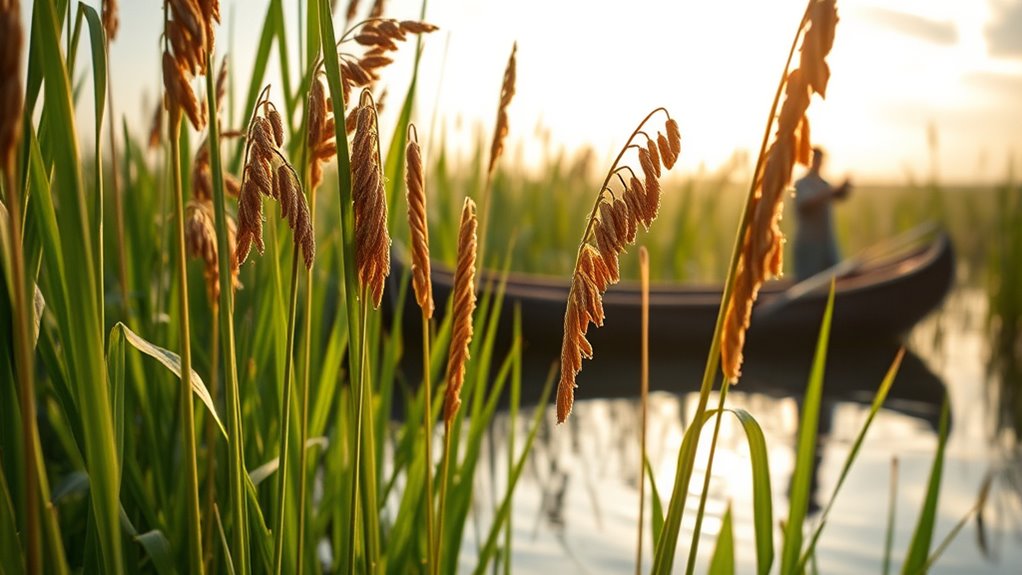
Timing your wild rice harvest is essential to guarantee you gather mature grains at their peak quality. The season typically begins mid- to late-August and lasts around three to five weeks, with the best harvest times usually from late August to mid-September. In some areas, harvesting may extend into early October if conditions allow. Since rice beds mature at different rates, multiple visits might be necessary to catch the peak ripeness. Keep a close eye on local conditions, such as water levels and plant color, to determine the ideal timing. Proper seasonal cues and understanding of growth stages can help optimize your harvest timing. Focus on shallow lakes, rivers, or marshes with light green beds visible in satellite imagery. Accessibility by canoe and gentle water currents can help improve your efficiency and ensure a sustainable, successful harvest. Proper cost and budgeting planning can also help you allocate resources for equipment or permits needed during your harvest. Monitoring growth stages in real-time helps ensure you’re harvesting at the optimal maturity for the best quality. Additionally, recognizing signs of wave and wind influence on plant health can inform the best times for harvesting to avoid erosion or damage. Staying informed about local water conditions can further enhance your success during the harvest period.
Traditional Techniques for Harvesting Wild Rice

Traditional techniques for harvesting wild rice rely on simple yet effective tools and methods passed down through generations. You’ll usually use lightweight birch bark canoes, though modern boats are common today. Steering through shallow waters requires skill with paddles and a keen eye for safe, efficient travel.
As the rice matures in late August, you work in pairs—one as the poler steering, the other as the harvester. Using long, flexible knockers, you bend rice stalks over the canoe and gently knock off the ripe grains. The grains are then collected in large sacks or containers attached to the boat.
This process demands physical effort and precision to avoid damaging the rice or environment. Your goal is to harvest sustainably, preserving the ecosystem and respecting cultural traditions. Sustainable harvesting techniques help ensure that wild rice populations remain abundant for future harvests, and understanding proper harvesting methods is crucial for maintaining ecological balance. Additionally, being aware of foraging regulations can help prevent unintended environmental impacts. Incorporating traditional knowledge about environmental impact can further enhance sustainable practices during harvest.
Proper Methods for Processing and Storing Wild Rice
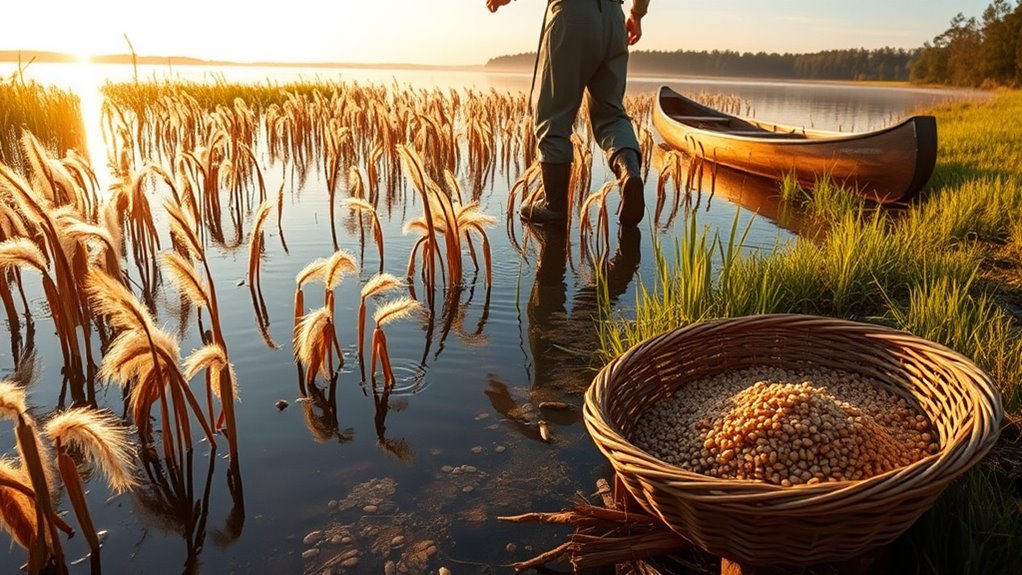
After harvesting wild rice, proper processing and storage are key to preserving its quality and flavor. Begin with parching, roasting the rice over a low heat or flame to loosen the husk and boost flavor. Kia Tuning techniques can inspire innovative methods to optimize the drying process for better preservation. Additionally, employing electricity production from bike generators can provide sustainable energy solutions for small-scale processing equipment, ensuring eco-friendly practices. The integration of automation in business can also streamline these processing steps, reducing manual effort and increasing efficiency. Utilizing energy-efficient appliances and considering vacuum sealing as an additional storage method can further extend the shelf life of your rice. Proper storage in a dry, cool, and airtight container prevents moisture and air exposure, which is vital for maintaining its flavor and nutritional value indefinitely without preservatives. When ready to cook, rinse thoroughly, then simmer in water or stock until tender but still slightly al dente. Ensuring proper storage methods can help preserve the rice’s quality over time.
Cultural Significance and Indigenous Practices
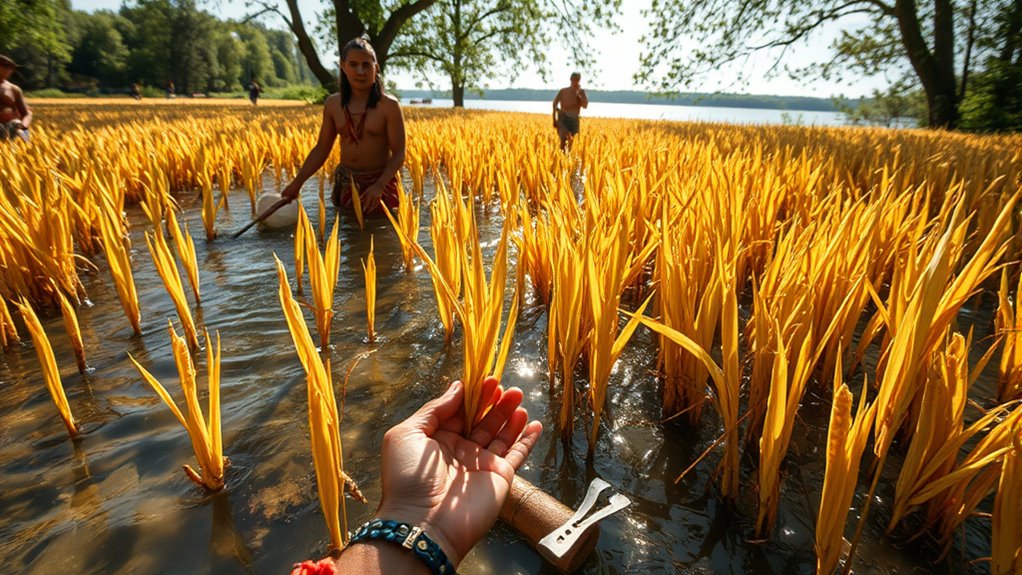
Wild rice holds profound cultural and spiritual significance for many Indigenous communities, especially the Anishinaabe. You should recognize it as a sacred gift from the Creator, symbolizing your community’s journey, land connection, and identity. Harvesting wild rice involves spiritual practices like offering tobacco to spirits, seeking good weather and a successful yield. It’s a communal activity, with families participating in ceremonies, feasts, and funerals centered around the harvest. Historically, wild rice was essential for your economy and cultural survival. The Ojibwe migrated to the Great Lakes seeking this water-grown food, fulfilling a prophecy. Today, efforts focus on preserving traditional methods and revitalizing cultural practices, emphasizing wild rice’s enduring role as a sacred symbol and crucial part of your heritage. Recognizing the spiritual significance of wild rice helps maintain its role in cultural identity and community cohesion. Understanding the importance of cultural practices underscores the deep connection between wild rice and Indigenous traditions. Additionally, sustainable harvesting methods are vital to ensure the continued abundance of this sacred resource for future generations. Incorporating traditional ecological knowledge can aid in protecting wild rice ecosystems and supporting sustainable management practices. Moreover, fostering community-led conservation initiatives ensures that these practices remain rooted in Indigenous stewardship and respect for the land.
Ensuring Sustainability and Protecting Wild Rice Ecosystems
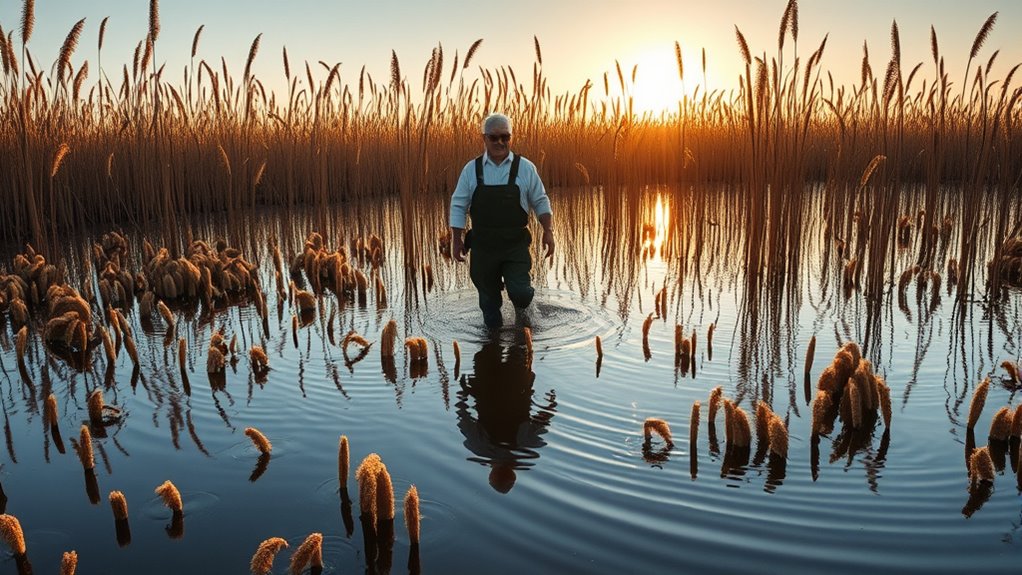
To guarantee the sustainability of wild rice, it’s essential to protect the delicate ecosystems where it thrives. Wild rice needs shallow freshwater environments with specific conditions, including proper nutrient levels, water clarity, pH balance, and dissolved oxygen. Excess nitrogen and phosphorus can cause harmful algae that block sunlight, harming the plants. High turbidity from suspended particles also limits sunlight, restricting photosynthesis. Additionally, 8K resolution advancements in display technology can help researchers document and monitor these ecosystems more effectively through high-definition imagery. Sustainable harvesting involves collaboration between communities, conservation groups, and regulators. Using eco-friendly equipment, adhering to strict rules, and issuing permits help prevent overharvesting. Climate change worsens these challenges by increasing water temperatures, disrupting water levels, and causing extreme weather, which threaten wild rice growth. Conservation efforts focus on protecting habitats, reseeding, and incorporating Indigenous knowledge to ensure wild rice ecosystems remain healthy for future generations. Ecosystem health is vital for maintaining biodiversity and supporting the long-term resilience of wild rice populations. Additionally, implementing monitoring programs can provide critical data to track the health of wild rice habitats and guide adaptive management strategies. Promoting awareness of aquatic biodiversity can further enhance community involvement in preserving these vital ecosystems.
Frequently Asked Questions
How Can I Distinguish Wild Rice From Similar Aquatic Plants?
To distinguish wild rice from similar aquatic plants, pay attention to its tall, grass-like appearance with flowering heads that rise above the water. Look for narrow, dark brown grains that are chewy and tender.
Notice the plant’s habitat, such as shallow lakes or marshes. Carefully observe the growth pattern, especially during mid-summer when the plants form extensive leafy mats.
Combining these features helps you identify wild rice accurately.
Are There Any Safety Precautions When Harvesting Wild Rice?
When harvesting wild rice, you need to follow safety precautions to protect yourself and the environment. Make sure your canoe is within size limits, and use muscle-powered paddles or push-poles to avoid damage.
Wear visible gear like flags or bright colors, and stick to designated hours and areas. Inspect your tools regularly, keep gear clean, and avoid rushing through rice beds to prevent accidents and environmental harm.
Can Wild Rice Be Harvested Sustainably in Private Ponds?
You can harvest wild rice sustainably in private ponds if you mimic natural conditions and follow best practices.
Guarantee the pond has suitable shallow water and proper soil, and use local seed sources to prevent invasiveness.
Manage water levels and quality carefully, and avoid overharvesting to allow plants to regenerate.
Regularly monitor environmental conditions, and follow local regulations to maintain a balanced, eco-friendly harvest that supports the pond’s health.
What Are Common Mistakes to Avoid During Processing?
When processing wild rice, you should avoid mistakes like overheating during parching, which causes burning and kernel loss. Don’t under- or over-roast, as it affects husk removal and kernel integrity.
Guarantee proper cooling and air drying to prevent spoilage. Use appropriate tools for hulling, rinse thoroughly, and remove chaff completely.
Store in airtight containers, avoiding moisture, light, and pests to keep your rice fresh and flavorful.
How Do Traditional Harvesting Methods Vary Among Indigenous Communities?
You’ll notice that traditional harvesting methods differ among indigenous communities, reflecting regional environments and cultural practices. Some communities use birch bark canoes, while others prefer modern boats.
Tool styles like knockers or sticks can vary, and ceremonies or timing may differ based on local traditions. Despite these differences, all communities share a deep respect for their methods and the land, ensuring the preservation of their cultural identity through these unique practices.
Conclusion
As you harvest wild rice, remember it’s more than just a tasty treat—it’s an essential ecosystem and cultural treasure. While you enjoy its delicate grains, consider the fragile wetlands that sustain it. The beauty of this aquatic delicacy lies in its dual nature: a delicious gift from nature and a sacred tradition needing your respect. Protecting these ecosystems ensures future generations can continue to savor and honor this timeless harvest.

